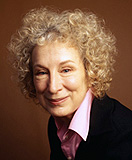News
An eclectic evening with Atwood
Mixing sardonic humor and whimsical optimism, celebrated Canadian author Margaret Atwood regaled her audience with answers to frequently asked questions about her life and art during her Distinguished Speakers Series lecture last night in the Center for the Arts.
Atwood also touched on diverse themes of literary preferences, Arctic travel and e-books during a wide-ranging question-and-answer session that followed her prepared remarks.
Atwood said she was making her first visit to UB since a 1980 Canadian poetry festival organized by the late Robert Creeley that took place “before I was a blond,” she said to audience laughter. When she was a teenager, Buffalo was dubbed “sin city” because of “girlie shows” and a younger drinking age than the more-staid Toronto society could offer at the time. “It was also a place where you could buy 14 dresses and put them all on—and waddle back across the border. Those were more innocent days. These days you might be patted down.”
Later, on bus trips from Toronto to Boston, Atwood experienced the cloud of White Owl cigar smoke wafting from fellow passengers that gradually increased as she preceded eastward. Passing through Buffalo in the middle of the night, she observed “enormous snow drifts.” Still, it was the only place where she wasn’t yet sick from the smoke.
Atwood poked fun at traditional Canadian reticence, especially in the wake of the Vancouver Winter Olympic Games. The idea promoted among Canadians of “owning the podium” is fundamentally an “un-Canadian” notion, she suggested. In Canadian terms, this newfound braggadocio might be better expressed as, “We kind of like podiums” or “A podium might be nice.”
Turning to her literary achievements, Atwood noted with amusement the queries she gets on why, for example, tins of sardines are frequently referenced in her novels, or why so many glass jars, eggs or bathtubs? Choosing the detail of sardine cans might have to do with her viewing the tiny fish as a “fallback food,” she said, and one likely associated with her experiences in the Canadian wilderness, “far away from the corner deli.”
In fact, said Atwood, she was distressed at a young age, when reading Sir Walter Scott’s “Ivanhoe” she realized that the character Rebecca—who was locked up in a tower—had nothing to eat and no bathtub. “It worried me a lot.” In her own novels, Atwood observed wryly, she makes a concerted effort to feed her characters and provide sanitation. This is not always done by writers of fiction, she pointed out. “In all of Dashiell Hammett, you’ll never find anyone eating anything, ever. They drink and smoke a lot—they never eat.”
Atwood went on to define “speculative fiction” as applied to her 2009 novel “The Year of the Flood.” She said her work differs from science fiction as it’s commonly understood—replete with far-away galaxies, other planets and Vulcan minefields. Because Atwood doesn’t offer such fantastical elements in her books, she doesn’t want to mislead her readers who might be expecting otherwise. In this respect, her work is more a descendant of Jules Verne than of H. G. Wells and his “The War of the Worlds.” Verne, she said, based his books on actual inventions and things people were really doing at the time. Moreover, his novels took place mostly on earth and involved human beings “and not people of green or blue hue with very visible ears and very strange tails,” alluding to the blockbuster film “Avatar.”
The author of more than 35 books representing numerous genres remains “a wild optimist.” In fact, optimism is a necessary condition for writers, she said, pointing out that they require a succession of favorable events: to be able to finish the book, find a publisher and get it reviewed. Then the writer must hope that readers will be able to obtain the book, and furthermore, that they will like and understand it.
“Hope is part of the human tool kit that we come with. …If you don’t have hope, there’s automatically a lot less of it in the world because you’re not going to make an effort. And if you do have hope, it’s a multiplier factor because you will make the effort. And by hope, I don’t mean just wishing. I mean acting in a hopeful way. And we need that particularly right now [when we’re in] a crisis moment in our history. The more people who act hopefully, the better chance we will have of coming through [this crisis].”
Asked during the Q&A session about her plans to go on another northern tour this summer as part of Adventure Canada’s Arctic cruises, Atwood gave haunting details of the beauty she has observed in the coastal waters off Greenland and the surrounding region. “You’ll see geography in a way you’ve never seen before,” she remarked. “You get an astonishing view of the bones of the earth.”
As for why she can and does write across so many genres (poetry, short stories, essays, screenplays, libretti and children’s books, in addition to her 15 novels), the much-honored Atwood responded that she’s “naturally ambidextrous,” although she finds writing reviews difficult because of the obligation to give frank assessments, and now reviews only those books she likes.
When one audience member asked her about the future of printed books in an age of the Kindle, Nook and similar devices, Atwood responded that e-books have their place in travel, waiting in the dentist’s office and other points of convenience. But they also are vulnerable to solar flares, energy shortages and Internet overload, referring the audience to her blog on this topic.
“Let me ask you the following question: When do you keep your will on the computer?”


Reader Comments